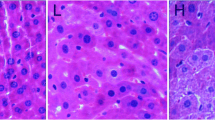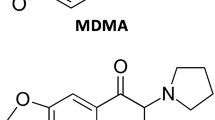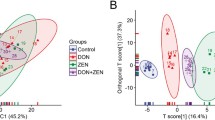Abstract
In the present study, both untargeted and targeted metabolomics approaches were used to evaluate the subacute effects of hexabromocyclododecane (HBCD) on mice urine metabolome. Untargeted metabolomics based on 1H NMR showed that HBCD exposure disturbed mice metabolism in both dosed groups, especially in high dosed group. The low-dose HBCD led to a decrease in alanine, malonic acid, and trimethylamine (TMA). High-dose HBCD-treated mice developed high levels of citric acid and 2-ketoglutarate, together with decreased alanine, acetate, formate, TMA, 3-hydroxybutyrate, and malonic acid. Targeted metabolomics for metabolic profiling of 20 amino acids identified alanine, lysine, and phenylalanine as significantly disturbed metabolites. These results indicated that subchronic exposure to HBCD caused a disturbance of mice metabolism, especially in TCA cycle, lipid metabolism, gut microbial metabolism, and homeostasis of amino acids, and the application of untargeted and targeted metabolomics combined with conventional toxicology approaches to evaluate the subacute effects of pollutants will provide more comprehensive information and aid in predicting health risk of these pollutants.






Similar content being viewed by others
References
Allchin CR, Morris S (2003) Hexabromocyclododecane (HBCD) diastereoisomers and brominated diphenyl ether congener (BDE) residues in edible fish from the rivers Skerne and Tees, UK. Organohalogen Compd 61:41–44
Beckonert O, Keun HC, Ebbels TM, Bundy J, Holmes E, Lindon JC, Nicholson JK (2007) Metabolic profiling, metabolomic and metabonomic procedures for NMR spectroscopy of urine, plasma, serum and tissue extracts. Nat Protoc 2:2692–2703
Cantón RF, Peijnenburg AA, Hoogenboom RL, Piersma AH, van der Ven L, van den Berg M, Heneweer M (2008) Subacute effects of hexabromocyclododecane (HBCD) on hepatic gene expression profiles in rats. Toxicol Appl Pharmacol 231:267–272
Committee POPR (2011): Hexabromocyclododecane, Draft Risk Management Evaluation. Prepared by the ad hoc working group on hexabromocyclododecane. Persistent Organic Pollutants Review Committee, April 2011, 24 p
Covaci A, Gerecke AC, Law RJ, Voorspoels S, Kohler M, Heeb NV, Leslie H, Allchin CR, de Boer J (2006) Hexabromocyclododecanes (HBCDs) in the environment and humans: a review. Environ Sci Technol 40:3679–3688
Darnerud PO (2003) Toxic effects of brominated flame retardants in man and in wildlife. Environ Int 29:841–853
de Wit CA (2002) An overview of brominated flame retardants in the environment. Chemosphere 46:583–624
Dumas ME, Barton RH, Toye A, Cloarec O, Blancher C, Rothwell A, Fearnside J, Tatoud R, Blanc V, Lindon JC, Mitchell SC, Holmes E, McCarthy MI, Scott J, Gauguier D, Nicholson JK (2006) Metabolic profiling reveals a contribution of gut microbiota to fatty liver phenotype in insulin-resistant mice. Proc Natl Acad Sci U S A 103:12511–12516
Eriksson P, Fischer C, Wallin M, Jakobsson E, Fredriksson A (2006) Impaired behaviour, learning and memory, in adult mice neonatally exposed to hexabromocyclododecane (HBCDD). Environ Toxicol Pharmacol 21:317–322
Holmes E, Nicholls A, Lindon J, Ramos S, Spraul M, Neidig P, Connor S, Connelly J, Damment S, Haselden J (1998) Development of a model for classification of toxin-induced lesions using 1H NMR spectroscopy of urine combined with pattern recognition. NMR Biomed 11:235–244
Issaq HJ, Abbott E, Veenstra TD (2008) Utility of separation science in metabolomic studies. J Sep Sci 31:1936–1947
Jobgen WS, Fried SK, Fu WJ, Meininger CJ, Wu G (2006) Regulatory role for the arginine–nitric oxide pathway in metabolism of energy substrates. J Nutr Biochem 17:571–588
Johnson-Restrepo B, Adams DH, Kannan K (2008) Tetrabromobisphenol A (TBBPA) and hexabromocyclododecanes (HBCDs) in tissues of humans, dolphins, and sharks from the United States. Chemosphere 70:1935–1944
Kaspar H, Dettmer K, Chan Q, Daniels S, Nimkar S, Daviglus ML, Stamler J, Elliott P, Oefner PJ (2009) Urinary amino acid analysis: a comparison of iTRAQ®–LC–MS/MS, GC–MS, and amino acid analyzer. J Chromatogr B 877:1838–1846
Koike E, Yanagisawa R, Takigami H, Takano H (2013) Brominated flame retardants stimulate mouse immune cells in vitro. J Appl Toxicol 33:1451–1459
Landfried K, Zhu W, Waldhier MC, Schulz U, Ammer J, Holler B, Wolff D, Edinger M, Peter K, Kreutz M, Andreesen R, Oefner PJ, Holler E (2011) Tryptophan catabolism is associated with acute GVHD after human allogeneic stem cell transplantation and indicates activation of indoleamine 2,3-dioxygenase. Blood 118:6971–6974
Lei R, Wu C, Yang B, Ma H, Shi C, Wang Q, Wang Q, Yuan Y, Liao M (2008) Integrated metabolomic analysis of the nano-sized copper particle-induced hepatotoxicity and nephrotoxicity in rats: a rapid in vivo screening method for nanotoxicity. Toxicol Appl Pharmacol 232:292–301
Li P, Yin Y-L, Li D, Woo Kim S, Wu G (2007) Amino acids and immune function. Br J Nutr 98:237–252
Lilienthal H, van der Ven L, Piersma AH, Vos JG (2009) Effects of the brominated flame retardant hexabromocyclododecane (HBCD) on dopamine-dependent behavior and brainstem auditory evoked potentials in a one-generation reproduction study in Wistar rats. Toxicol Lett 185:63–72
McCombie G, Browning LM, Titman CM, Song M, Shockcor J, Jebb SA, Griffin JL (2009) ω-3 oil intake during weight loss in obese women results in remodelling of plasma triglyceride and fatty acids. Metabolomics 5:363–374
Morris S, Allchin CR, Zegers BN, Haftka JJ, Boon JP, Belpaire C, Leonards PE, Van Leeuwen SP, de Boer J (2004) Distribution and fate of HBCD and TBBPA brominated flame retardants in North Sea estuaries and aquatic food webs. Environ Sci Technol 38:5497–5504
Nicholson JK, Lindon JC, Holmes E (1999) ‘Metabonomics’: understanding the metabolic responses of living systems to pathophysiological stimuli via multivariate statistical analysis of biological NMR spectroscopic data. Xenobiotica 29:1181–1189
Rhoads JM, Wu G (2009) Glutamine, arginine, and leucine signaling in the intestine. Amino Acids 37:111–122
Saegusa Y, Fujimoto H, Woo G-H, Inoue K, Takahashi M, Mitsumori K, Hirose M, Nishikawa A, Shibutani M (2009) Developmental toxicity of brominated flame retardants, tetrabromobisphenol A and 1, 2, 5, 6, 9, 10-hexabromocyclododecane, in rat offspring after maternal exposure from mid-gestation through lactation. Reprod Toxicol 28:456–467
Schriks M, Roessig JM, Murk AJ, Furlow JD (2007) Thyroid hormone receptor isoform selectivity of thyroid hormone disrupting compounds quantified with an in vitro reporter gene assay. Environ Toxicol Pharmacol 23:302–307
Shi Z-X, Wu Y-N, Li J-G, Zhao Y-F, Feng J-F (2009) Dietary exposure assessment of Chinese adults and nursing infants to tetrabromobisphenol-A and hexabromocyclododecanes: occurrence measurements in foods and human milk. Environ Sci Technol 43:4314–4319
Sun Y-J, Wang H-P, Liang Y-J, Yang L, Li W, Wu Y-J (2012) An NMR-based metabonomic investigation of the subacute effects of melamine in rats. J Proteome Res 11:2544–2550
Szabo DT, Pathmasiri, W., Diliberto, J.J., Sumner, S., Birnbaum, L.S. (2011): Metabolomic analysis of serum after treatment with the emerging pop flame retardant hexabromocyclododecane (HBCD): Commercial mixture, alpha and gamma stereoisomers elicit differential effects in infantile mice. Toxicologist 20 (Suppl. 2, Abstract No. 2248):482
Trygg J, Holmes E, Lundstedt T (2007) Chemometrics in metabonomics. J Proteome Res 6:469–479
van der Ven LT, Verhoef A, Van De Kuil T, Slob W, Leonards PE, Visser TJ, Hamers T, Herlin M, Håkansson H, Olausson H (2006) A 28-day oral dose toxicity study enhanced to detect endocrine effects of hexabromocyclododecane in Wistar rats. Toxicol Sci 94:281–292
van der Ven L, van de Kuil T, Leonards PE, Slob W, Lilienthal H, Litens S, Herlin M, Håkansson H, Cantón RF, van den Berg M (2009) Endocrine effects of hexabromocyclododecane (HBCD) in a one-generation reproduction study in Wistar rats. Toxicol Lett 185:51–62
Wu G (2009) Amino acids: metabolism, functions, and nutrition. Amino Acids 37:1–17
Wu G, Bazer F, Datta S, Johnson G, Li P, Satterfield M, Spencer T (2008) Proline metabolism in the conceptus: implications for fetal growth and development. Amino Acids 35:691–702
Zheng S, Zhang S, Yu M, Tang J, Lu X, Wang F, Yang J, Li F (2011) An 1H NMR and UPLC–MS-based plasma metabonomic study to investigate the biochemical changes in chronic unpredictable mild stress model of depression. Metabolomics 7:413–423
Acknowledgments
We gratefully acknowledge financial support of National Natural Science Foundation of China (21207158, 21337005) and Chinese Universities Scientific Fund (2012RC026).
Author information
Authors and Affiliations
Corresponding author
Ethics declarations
Conflict of interest
The authors report no declarations of interest.
Additional information
Responsible editor: Philippe Garrigues
Rights and permissions
About this article
Cite this article
Wang, D., Zhang, P., Wang, X. et al. NMR- and LC–MS/MS-based urine metabolomic investigation of the subacute effects of hexabromocyclododecane in mice. Environ Sci Pollut Res 23, 8500–8507 (2016). https://doi.org/10.1007/s11356-015-5940-2
Received:
Accepted:
Published:
Issue Date:
DOI: https://doi.org/10.1007/s11356-015-5940-2




